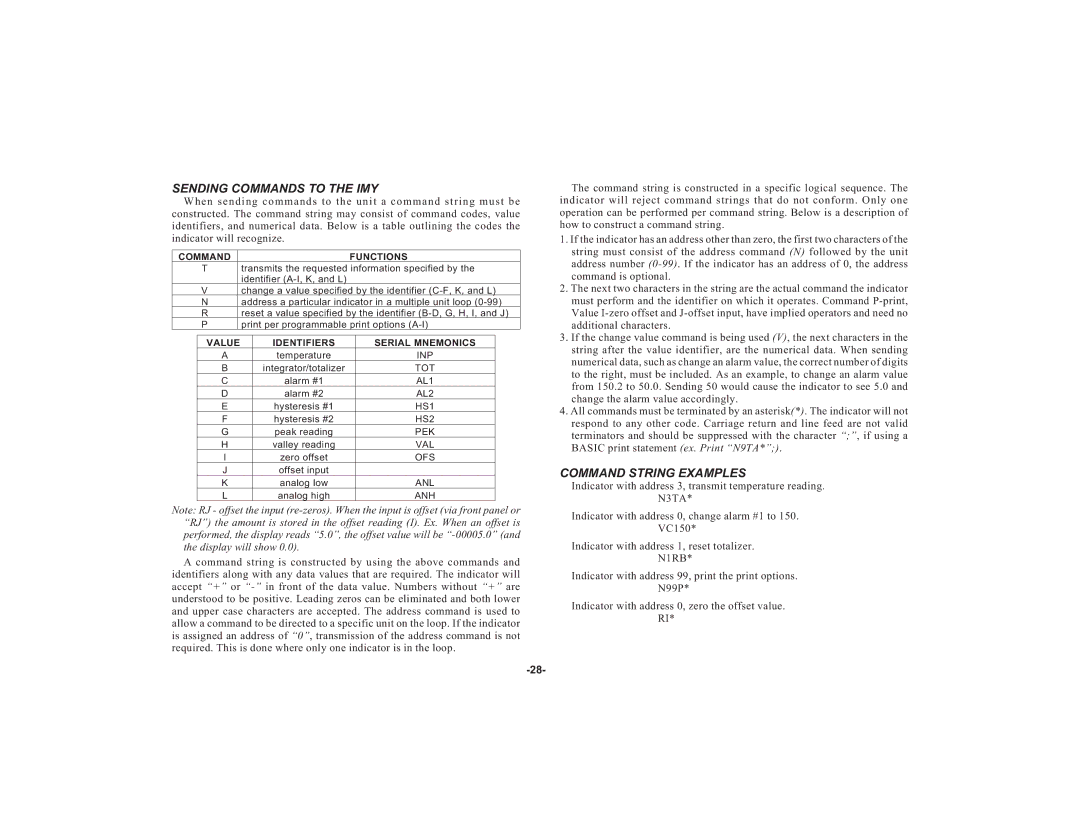
SENDING COMMANDS TO THE IMY
When sending commands to the unit a command string must be constructed. The command string may consist of command codes, value identifiers, and numerical data. Below is a table outlining the codes the indicator will recognize.
COMMANDFUNCTIONS
Ttransmits the requested information specified by the identifier
Vchange a value specified by the identifier
N address a particular indicator in a multiple unit loop
R reset a value specified by the identifier
P print per programmable print options
VALUE | IDENTIFIERS | SERIAL MNEMONICS |
A | temperature | INP |
B | integrator/totalizer | TOT |
C | alarm #1 | AL1 |
D | alarm #2 | AL2 |
E | hysteresis #1 | HS1 |
F | hysteresis #2 | HS2 |
G | peak reading | PEK |
H | valley reading | VAL |
I | zero offset | OFS |
J | offset input |
|
K | analog low | ANL |
L | analog high | ANH |
Note: RJ - offset the input
A command string is constructed by using the above commands and identifiers along with any data values that are required. The indicator will accept “+” or
The command string is constructed in a specific logical sequence. The indicator will reject command strings that do not conform. Only one operation can be performed per command string. Below is a description of how to construct a command string.
1.If the indicator has an address other than zero, the first two characters of the string must consist of the address command (N) followed by the unit address number
2.The next two characters in the string are the actual command the indicator must perform and the identifier on which it operates. Command
3.If the change value command is being used (V), the next characters in the string after the value identifier, are the numerical data. When sending numerical data, such as change an alarm value, the correct number of digits to the right, must be included. As an example, to change an alarm value from 150.2 to 50.0. Sending 50 would cause the indicator to see 5.0 and change the alarm value accordingly.
4.All commands must be terminated by an asterisk(*). The indicator will not respond to any other code. Carriage return and line feed are not valid terminators and should be suppressed with the character “;”, if using a BASIC print statement (ex. Print “N9TA*”;).
COMMAND STRING EXAMPLES
Indicator with address 3, transmit temperature reading.
N3TA*
Indicator with address 0, change alarm #1 to 150.
VC150*
Indicator with address 1, reset totalizer.
N1RB*
Indicator with address 99, print the print options.
N99P*
Indicator with address 0, zero the offset value.
RI*
